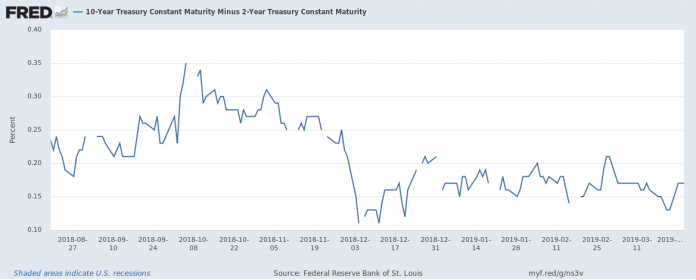As explained in the past, Yield Curves reflect investor expectations about future developments in the bond markets and their perceptions of overall risk. Basically, the idea is that the longer the bond duration the higher the yield should be in order to cover the extra cost of keeping the bond for a long time; thus, longer duration bonds should have higher yields than short-term bonds.
Still, this is not always the case, and this is where expectations enter the equation: if bond market participants are expecting interest rates to decline in the future, they are more willing to secure their funds in the higher-yielding longer-duration bonds. Thus, as investors flock to longer duration bonds their prices increase and their yield declines, pushing it closer to short-term yields.
Another, and immensely more popular, justification for this reduction in bond yields is that investors fear that a recession is coming and they seek to secure their funds in the bond market. As the duration of the potential recession is unknown, they prefer to purchase long-term bonds, which offer both the benefit of safety and (usually) higher yields. The rationale remains the same: as investors move to longer-term bonds, their price increases and their yield decreases.
It is true that in most cases the two explanations coincide: when a recession is imminent, investors seek long-duration bonds both because they expect the economy to deteriorate as well as because they know that during recessions Central Banks lower policy rates.
The long and short bond rates have been converging for the past year, with the difference between the two fluctuating between 0.1 and 0.2 since January. While a slowdown in US economic growth has been confirmed, especially with the Q4 revision yesterday to 2.2%, the country’s performance still remains far from being recorded as a recession. Furthermore, Fed funds futures are pricing more than a 30 bps easing by the end of 2019, with the Reserve Bank of New Zealand being the first Central Bank to admit that the next rate move will likely be a cut.
The point to be made is straightforward: if growth persists above 2% in the first quarter of the year, the Fed will likely not move interest rates. In the opposite case, where growth declines below 2%, a more likely scenario given the effects from the US government shutdown in January, the Fed will likely proceed with some rate hikes, in order to boost domestic consumption.
Click here to access the HotForex Economic Calendar
Dr Nektarios Michail
Market Analyst
HotForex
Disclaimer: This material is provided as a general marketing communication for information purposes only and does not constitute an independent investment research. Nothing in this communication contains, or should be considered as containing, an investment advice or an investment recommendation or a solicitation for the purpose of buying or selling of any financial instrument. All information provided is gathered from reputable sources and any information containing an indication of past performance is not a guarantee or reliable indicator of future performance. Users acknowledge that any investment in FX and CFDs products is characterized by a certain degree of uncertainty and that any investment of this nature involves a high level of risk for which the users are solely responsible and liable. We assume no liability for any loss arising from any investment made based on the information provided in this communication. This communication must not be reproduced or further distributed without our prior written permission.



















